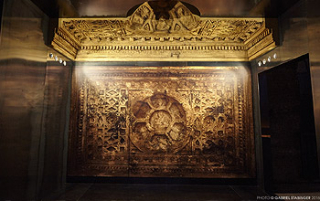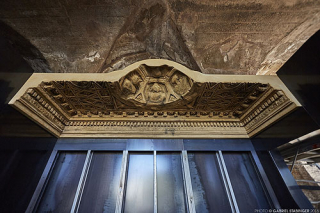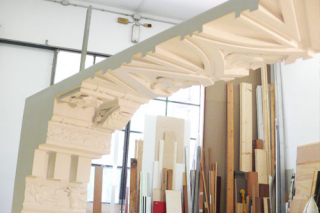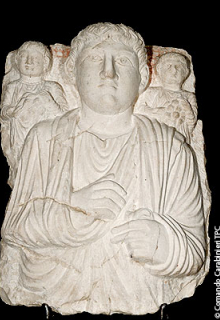The 30th General Assembly of ICCROM will be the occasion for a Thematic Discussion on reconstruction of destroyed or damage historic cities entitled ‘Post-Conflict Reconstruction – Recovery and Community Involvement’, based on the symposium held at Louvre Lens in January 2017.
To support and buttress the discussions, two side exhibitions will be held, at FAO premises and the Egyptian Academy.
The exhibit Palmyra: Rising from Destruction, a joins a reconstructed archaeological element and a heritage objects related to that site. The exhibit is sponsored by the Incontro di Civiltà Association headed by Francesco Rutelli, former Italian Minister of Culture, which also carried forward the reconstruction of a destroyed Bel Temple ceiling, back to life through state-of-the-art technology.
Ceiling of the Temple of Bel, Palmyra
The monumental temple dedicated to Bel, the main deity of Palmyra, was built inside a large, roughly square enclosure, with sides nearly 200 m long. It was dedicated on 6 Nisan (April) 32 CE, a date likely chosen to commemorate the victory of the Babylonian god Marduk over Tiamat, the embodiment of chaos.
The temple was later converted into a church, and by the 8th century into a mosque. The imposing building – measuring 39.45 x 13.86 m – is characterized by two cellas (inner chambers), higher than the floor level, called the southern adyton and northern adyton. Both featured a carved monolithic ceiling. The southern adyton was decorated with floral and geometric motifs around a large central rosette, whereas the northern adyton – whose partial reconstruction is presented here – had a more complicated pattern.
In the monolith’s central circle is depicted the god Bel, Lord of the skies who governs the motion of the stars. He is surrounded by six busts, personifications of the six planets known at the time — Saturn, Jupiter, Mars, Venus, Mercury and Moon — and by a band with the twelve signs of the Zodiac.
The Temple of Bel is an ideal example of the refinement of Palmyrene workmanship and of their capacity to adopt elements from different cultures. Though the artisans were mainly local, Greek craftsmen also worked there. The ceiling of the northern adyton is a wonderful synthesis of the cosmological knowledge and artistic skills of the Palmyrans.
In summer 2015, the Temple of Bel and the two monolithic ceilings of the cellas were destroyed by militants of the so-called Islamic State during their occupation of the site. This was done with explosives placed inside the main building.
Reconstruction process
This reconstruction was carried out by TryeCo 2.0 S.r.l. The methodology used called for a sequence of procedures – analysis, modelling and construction – to arrive at a coherent copy.
The first step involved understanding the artefact through research and analysis of available historical records. The derived data were used to create a CAD digital model. To preserve the proportions, a logical sequence of data capture was followed to arrive at a faithful representation —from the architecture to the decorative motifs, from larger features to more detailed ornamentation.
The resulting virtual model depicts the ceiling as it would have looked immediately after completion by sculptors in antiquity, without the wear and damage of time. The exception is the figures inside the circular dome, which were too deteriorated to be reconstructed faithfully.
The digital model data were then used to craft the components using Computer Numerical Control (CNC) machines. The basic architectural shape was made using a hot wire cutting machine that automatically shapes the components exported from the CAD drawings. Starting from a large block of polystyrene, the various elements were cut using a system of pulleys and mechanisms that allowed the hot metal wire to run through the polystyrene.
This system was used to create 140 different elements, the smallest having sides of 10 cm, and the largest 1.4 m. The dome section, rich with sculptural elements, was made in five parts and was milled using an anthropomorphic six-axis robotic arm. To streamline production, the decorative ceiling elements were created separately using a technique called “rapid prototyping”, and then applied to a carved base.
Two different 3D printing techniques were used. Complex and richly decorated elements were made using a professional chalk powder 3D printer, while simpler elements were made with a thermoplastic FDM printer. All printed components were joined with epoxy resins, and the entire artefact was covered with a thin layer of synthetic chalk enhanced with oxides and sandstone powder to obtain the look of original stone. The reconstruction was then manually aged and coated with a protective layer of transparent opaque acrylic.
This reconstruction measures 451.5 x 141.5 cm and weighs about 190 kg.
The Incontro di Civiltà Association is also currently sponsoring an exhibit of its reconstructed winged Bull of Nimrud at UNESCO Headquarters in Paris, France, through November 2017.
The Carabinieri Command for the Protection of Cultural Heritage is also contributing to the exhibit with the display of an illegally trafficked funeral bust from the site of Palmyra.
The Palmyra relief exhibited here represents the tireless work of the Carabinieri Command for the Protection of Cultural Heritage to halt the worldwide illicit trafficking of antiquities.
Made of limestone, this relief is a figurative plate used to seal niches in large chamber tombs. Other such artefacts can be found in the richest tombs of the so-called “Valley of the Tombs” in Palmyra. The relief shows three figures: a young man wearing a mantel, perhaps the founder of the family, with his two sons. These sculptural figures are depicted in frontal view, expressions solemn, hands resting on their mantel drapery.
Illegally excavated from Palmyra, the object was unlawfully exported from Syria in the early 2000s. The Carabinieri seized the sculpture in 2011 from the house of a private collector in Asti, a town in northwest Italy. The relief will be returned to Syria as soon as the general security conditions in Syria allow.
Today we are witnessing unprecedented attacks on cultural heritage by terrorist groups during conflict situations, attacks which dramatically impact on national identity and social cohesion, hindering peace building and post-conflict recovery. The attacks undermine values such as tolerance, respect and inclusiveness, while seeking to divide and intimidate societies. The plundering and trafficking of cultural goods causes irreparable damage to the cultural heritage of humankind, and corrupts the archaeological integrity of sites.
In 2016, Italy and UNESCO established the first national Task Force to protect ancient cultural artifacts from extremists in crisis areas. The Italian Unite4Heritage Task Force consists of 30 units of the specialized Carabinieri Command for the Protection of Cultural Heritage, and 30 experts from the Ministry of Culture.
The photo exhibit at the Egyptian Academy, “The Day After: Shadows of Heritage” brings together before and after photos of heritage sites in four countries to bear witness to the scale of the devastation.
THE DAY AFTER: SHADOWS OF HERITAGE
“The Day After: Shadows of Heritage”, is a photography exhibition that depicts the destruction of significant historic buildings, structures and cities, previously jewels of heritage, now abandoned in ruins. Though the integrity of these places has been affected, with the rubble on the ground casting a shadow on what once was a heritage structure, the aura of these buildings and sites persists and recalls the authenticity of its original remains.
This exhibition focuses on four Arab countries – Syria, Iraq, Libya and Yemen – which have recently experienced armed conflicts and wars, presenting selected sites before and after the conflict and illustrating the extent of the damage.
This photography exhibition gives to the international community of heritage professionals convened at ICCROM’s 30th General Assembly a moment of reflection, by bringing to the forefront the conditions of cities and buildings in the post-conflict contexts. More importantly, it calls attention to how international cooperation can be most effective in a recovery phase - the subject of the thematic session.
The ICCROM-ATHAR network of professionals, experts, and course participants, as well as partner institutions actively engaged in their respective countries, contributed the images on display in this exhibition.
The exhibition will be held until the end of January 2018, at the Egyptian Academy in Rome.
ICCROM thanks all our generous sponsors and partners for their case studies contributing to the thematic discussion.




